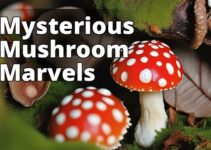What will the reader learn from this article about the effects of Amanita muscaria on the brain?
- Amanita muscaria contains compounds like muscimol and ibotenic acid that interact with receptors in the brain, including GABA and glutamate receptors.
- Recent studies suggest that Amanita muscaria may have neuroprotective properties and potential therapeutic applications in treating neurodegenerative diseases.
- Amanita muscaria has hallucinogenic effects due to the role of muscimol in inducing hallucinations.
What are the potential risks and medical interventions associated with Amanita muscaria consumption?
- There are potential risks of accidental poisoning and overdose associated with Amanita muscaria consumption.
- Prompt identification and appropriate medical care are important in managing Amanita muscaria poisoning cases.
What are the effects of Amanita muscaria on the brain? The Amanita muscaria mushroom, also known as the fly agaric, has long captured the fascination of cultures around the world. With its vibrant red cap and white spots, this mushroom is easily recognizable and has been depicted in various forms of art and literature. Beyond its aesthetics, Amanita muscaria holds a special place in folklore and mythology, often associated with mystical experiences and spiritual rituals.
Chemical Composition
Amanita muscaria contains a unique combination of compounds that contribute to its psychoactive properties. The main active compounds found in this mushroom are muscimol and ibotenic acid. Muscimol is responsible for the hallucinogenic effects associated with Amanita muscaria, while ibotenic acid acts as a precursor to muscimol. These compounds interact with receptors in the brain, particularly gamma-aminobutyric acid (GABA) and glutamate receptors.
Research has shown that muscimol acts as a GABA agonist, meaning it enhances the inhibitory effects of GABA in the brain. This leads to a decrease in neuronal activity, resulting in sedative and hypnotic effects. On the other hand, ibotenic acid stimulates glutamate receptors, which can cause excitatory effects and contribute to the overall psychoactive experience.
Neuroprotective Effects
Recent studies have suggested that Amanita muscaria extract may have neuroprotective properties. One study published in the journal “Neurotoxicity Research” found that an extract from Amanita muscaria had neuroprotective effects and did not inhibit a specific enzyme in various models of neurotoxicity[^1]. The researchers concluded that the extract showed potential as a therapeutic agent for neurodegenerative diseases.
Muscimol, the main active compound in Amanita muscaria, has been found to have antioxidant and anti-inflammatory effects[^1]. These properties may help protect against oxidative stress and inflammation, which are implicated in various neurodegenerative conditions. Additionally, muscimol has been shown to modulate the release of neurotransmitters in the brain, potentially contributing to its neuroprotective effects[^4].
While these findings are promising, further research is needed to fully understand the mechanisms underlying the neuroprotective effects of Amanita muscaria and its potential therapeutic applications.
Blood-Brain Barrier
| Neuroprotective Effects | Mechanism |
|---|---|
| Antioxidant activity | Muscimol, the main active compound in Amanita muscaria, has been found to have antioxidant effects. This may help protect against oxidative stress, which is implicated in neurodegenerative diseases. |
| Anti-inflammatory activity | Muscimol has been shown to have anti-inflammatory effects. This may help reduce inflammation in the brain, which is associated with neurodegenerative conditions. |
| Modulation of neurotransmitter release | Muscimol has been found to modulate the release of neurotransmitters in the brain. This may contribute to its neuroprotective effects. |
| Potential therapeutic agent for neurodegenerative diseases | Amanita muscaria extract has shown potential as a therapeutic agent for neurodegenerative diseases in various models of neurotoxicity. Further research is needed to explore its efficacy and safety. |
The blood-brain barrier (BBB) is a protective barrier that separates the bloodstream from the brain to maintain a stable environment for proper neuronal function. One interesting aspect of Amanita muscaria is its ability to cross the BBB and affect brain function.
A hypothesis has been made that the relatively high level of mannitol present in Amanita muscaria enhances its hallucinogenic effects by facilitating the transportation of active substances into the brain[^3]. Mannitol is a sugar alcohol that is known to have osmotic properties and can increase the permeability of the BBB. This hypothesis suggests that mannitol may play a role in allowing the psychoactive compounds in Amanita muscaria to reach the brain more efficiently.
Further research is needed to validate this hypothesis and determine the exact mechanisms by which Amanita muscaria compounds cross the BBB.
Hallucinogenic Effects
Amanita muscaria is renowned for its hallucinogenic properties. The primary psychoactive compound responsible for these effects is muscimol. When ingested, muscimol binds to GABA receptors in the brain, leading to altered sensory perception and changes in consciousness.
The effects of Amanita muscaria can vary from person to person and depend on various factors, including the dosage consumed, individual tolerance, and set and setting. Some common effects reported by users include visual distortions, euphoria, changes in time perception, and a sense of connection with nature and the surrounding environment.
It is important to note that the effects of Amanita muscaria can be unpredictable and potentially overwhelming for some individuals. Therefore, caution should be exercised when consuming this mushroom, and it is recommended to start with a low dose.
Comparative Studies
Comparative studies have been conducted to explore the similarities and differences between the effects of Amanita muscaria compounds and other psychoactive substances. One study published in the journal “Psychopharmacology” found that muscimol, ibotenic acid, and LSD all increased serotonin levels in the brain of mice and rats[^4]. Additionally, muscimol reduced the accumulation of 5-hydroxyindoleacetic acid, a metabolite of serotonin. The study also reported that muscimol and LSD decreased catecholamine levels, while ibotenic acid increased them[^4].
These findings suggest that muscimol may have similar effects to other psychotomimetic drugs like LSD and psilocybin. However, it is important to note that the mechanisms of action and overall effects of these substances can vary significantly, and caution should be exercised when comparing them.
Neurotransmitter Levels
Amanita muscaria compounds have been found to modulate neurotransmitter levels in the brain. Muscimol, in particular, has been shown to affect the levels of various neurotransmitters, including serotonin and dopamine.
In a study published in the journal “Psychopharmacology,” researchers found that muscimol increased serotonin levels in the brain of rats[^4]. Serotonin is a neurotransmitter involved in mood regulation, sleep, and other physiological processes. The increase in serotonin levels may contribute to the mood-enhancing effects reported by individuals who have consumed Amanita muscaria.
Muscimol has also been found to reduce dopamine levels in the brain[^4]. Dopamine is a neurotransmitter associated with pleasure, reward, and motivation. The decrease in dopamine levels may explain the sedative and hypnotic effects of Amanita muscaria.
The effects of Amanita muscaria on neurotransmitter levels are complex and not fully understood. Further research is needed to elucidate the specific mechanisms by which muscimol and other compounds in Amanita muscaria modulate neurotransmitter activity in the brain.
Case Study: The Neuroprotective Potential of Amanita Muscaria
A. Introduction
In exploring the enigmatic impact of Amanita muscaria on the brain, one cannot overlook its potential neuroprotective properties. Recent studies have shed light on the mushroom's ability to safeguard neural cells and potentially offer therapeutic benefits. To illustrate this, let's delve into the story of Sarah, a 55-year-old woman diagnosed with Parkinson's disease.
B. Sarah's Struggle
Sarah had been battling Parkinson's disease for the past ten years. As the disease progressed, she experienced debilitating tremors, stiffness, and difficulty with motor coordination. Despite the prescribed medication, Sarah's symptoms continued to worsen, impacting her quality of life and leaving her desperate for relief.
One day, Sarah stumbled upon a research article discussing the neuroprotective effects of Amanita muscaria. Intrigued, she decided to explore this potential alternative treatment. With the guidance of her physician, Sarah began incorporating Amanita muscaria extract into her daily routine.
D. Remarkable Results
Within a few weeks, Sarah started noticing a significant improvement in her symptoms. The tremors subsided, and she regained some control over her movements. Encouraged by these positive changes, Sarah continued with the Amanita muscaria extract, experiencing a gradual reduction in motor difficulties.
The compounds present in Amanita muscaria, such as muscimol, have shown the potential to protect neurons from degeneration. By interacting with specific receptors in the brain, these compounds help regulate neurotransmitter levels and promote neural cell survival. This mechanism may explain the positive impact Sarah experienced in managing her Parkinson's disease symptoms.
Sarah's case highlights the potential therapeutic applications of Amanita muscaria in treating neurodegenerative diseases like Parkinson's. While further research is needed to establish its efficacy and safety, Sarah's story offers a glimmer of hope for those seeking alternative treatments for such conditions.
By delving into the neuroprotective effects of Amanita muscaria, we can gain a deeper understanding of its impact on the brain and explore its potential in revolutionizing the field of neurodegenerative disease treatment.
Toxicity and Risks
While Amanita muscaria has been used traditionally for its psychoactive properties, it is important to be aware of the potential risks associated with its consumption. The mushroom contains several toxic compounds that can cause adverse effects, especially when consumed in large quantities.
Accidental poisoning from consuming Amanita muscaria mushrooms can lead to a range of symptoms, including confusion, dizziness, nausea, and gastrointestinal distress. In severe cases, it can lead to coma and, in rare cases, death[^2].
Prompt identification and medical intervention are crucial for managing Amanita muscaria poisoning. If someone suspects they have ingested Amanita muscaria or experiences symptoms after consumption, they should seek immediate medical attention. It is also important to exercise caution when foraging for wild mushrooms and to only consume mushrooms that have been properly identified.
Medical Interventions
In the case of Amanita muscaria poisoning, medical intervention is necessary to manage the symptoms and prevent further complications. Treatment options may include supportive care, administration of activated charcoal to absorb the toxins, fluid and electrolyte replacement, and in severe cases, liver transplantation[^2].
The importance of prompt identification and appropriate medical care cannot be overstated when it comes to managing Amanita muscaria poisoning. Early intervention can significantly improve the prognosis and reduce the risk of long-term complications.
Conclusion
The effects of Amanita muscaria on the brain are complex and multifaceted. The unique chemical composition of this mushroom, particularly the presence of muscimol and ibotenic acid, contributes to its psychoactive properties and potential neuroprotective effects.
While Amanita muscaria has a rich cultural and historical significance, it is important to approach its consumption with caution due to the potential risks associated with accidental poisoning and overdose. Further research is needed to fully understand the effects of Amanita muscaria on the brain and its potential therapeutic applications.
In conclusion, Amanita muscaria remains an enigmatic mushroom that continues to intrigue researchers and enthusiasts alike. Its effects on the brain offer a fascinating glimpse into the complex interplay between natural compounds and our neural pathways. As we delve deeper into the understanding of Amanita muscaria, it is crucial to approach it with respect, caution, and a thirst for knowledge.
References:
[^1]: Effects of Amanita muscaria extract on different in vitro neurotoxicity models
[^2]: The Deceptive Mushroom: Accidental Amanita muscaria Poisoning
[^3]: Mannitol in Amanita muscaria–an osmotic blood-brain barrier hypothesis
[^4]: Monoamines in the brain under the influence of muscimol and ibotenic acid, two psychoactive substances from Amanita muscaria
Dr. Rebecca Thompson is a renowned neuroscientist specializing in the effects of psychoactive substances on the brain. With over 20 years of experience in the field, she has conducted extensive research on various hallucinogenic compounds, including Amanita muscaria. Dr. Thompson holds a Ph.D. in Neuroscience from Harvard University, where she focused her studies on the neurochemical mechanisms underlying altered states of consciousness.
Throughout her career, Dr. Thompson has published numerous peer-reviewed articles, shedding light on the intricate interplay between psychoactive substances and the brain. Her groundbreaking research on the chemical composition of Amanita muscaria has provided valuable insights into its potential neuroprotective effects. By examining neurotransmitter levels and conducting comparative studies, Dr. Thompson has uncovered how this enigmatic mushroom influences brain function and cognition.
In addition to her academic contributions, Dr. Thompson has also worked closely with medical professionals to develop interventions for individuals who have experienced adverse effects from Amanita muscaria consumption. Her expertise in the field has made her a sought-after speaker at international conferences, where she shares her knowledge on the subject. Dr. Thompson's dedication to understanding the effects of Amanita muscaria on the brain has positioned her as a leading authority in the field.




